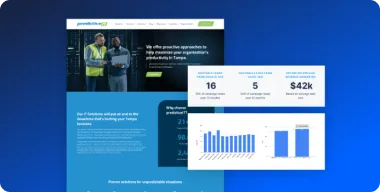Remember the last time you ran a marketing campaign? What did you do once it was over? If you’re like most people, you likely didn’t get as many leads or sales as you’d hoped, you sulked for a bit and then moved on to your next most important project. Maybe you’d try again in the future.
While many of us are guilty of taking the insights from our campaigns for granted, a few others are actually using their marketing data to create effective marketing strategies. That said, there’s a reason why not everyone does this: it’s much harder than it sounds and requires ongoing effort. This blog will show you how you can get started monitoring and analyzing your marketing campaigns and why it can make a difference in the success of your small business.
The benefits of monitoring and analysis

Most marketing campaigns do not succeed out of the gate. Being successful with marketing in the long term requires learning from your campaigns, especially the ones that crash and burn, since they’ll teach you about your target audience and which of your products or services they need most.
When you monitor and analyze campaigns (email newsletters, pay-per-click advertising, etc.), you have the chance to dig in and see how things are actually performing. In the event that the levels of success are low, you need to drill down and figure out what the problem is. At that point you can decide whether to reinvest in improving your campaign, or call it quits so you can focus on new ones but gaining knowledge along the way.
When a campaign is going particularly well, you can “follow the bright spots” and learn from them to ensure your future campaigns are just as successful.
Do you know what your customers are saying about you?
Your customers, the members of your target audience, are the base on which the success of your company is built. You need to know which marketing techniques are effective in their eyes, and tracking the rise and fall of your business operations reveals that information.
When you find a particular advertisement, slogan, or other marketing technique that sticks with them, build it up. You can incorporate it into promotional items, or inject it into your social media posts. Gauging your customers’ reactions helps you create a branding image that can last a lifetime.
On the other hand, when the reactions to a particular campaign are negative, or when you simply cannot generate profit based on one of them, you’re not only learning that the campaign is unsuccessful, but you’re also getting a taste of what the audience doesn’t like.
Take the feedback and the new information you have learned from both the profitable and unsuccessful campaigns into consideration when creating your future campaigns. This way, you will be a step closer to what your customers are looking for.
Are you constantly improving your techniques even if they’re already top-notch?
When you find a strategy that works well, you might be tempted to just let it be. You figure that it has already generated a high level of success, so you don’t need to improve it. However, your customers and the competitive landscape are not going to remain the same forever, and neither should your message.
For example, consider a product targeting individuals in their 20s. Although you want to keep that market, you also want to retain these customers when they move into the next decade of their lives. Updating the product, as well as the marketing campaigns that go along with it, can make these people lifelong customers.
Are you making the most of your budget?
When you are monitoring and analyzing your campaign, you’ll start to see how the money you put in either generates profit or leads to a loss. This benefit or consequence is tangible and measurable, and the ability to do so may very well lead to a high level of success on your end. When you learn the components that make your company tick, you can spend more money on them and put away the techniques that drain your company out of a profit.
If you’re unsure how to get started budgeting for campaigns, read this blog: How much should my small business spend on advertising?
Are you building a strong online reputation?
In addition to ensuring that your finances are sturdy, you also want to be certain you have a solid digital reputation. By analyzing how people are responding to your Marketing Campaigns on social media outlets and review boards, you can gain a sense of what your online reputation is and why. Once you know where you stand, you can work to either repair the problem or tweak strategies to garner even better reviews.
For a more extensive read on brand reputation management, read our blog post on the 10 Tips to make your company’s reputation even more positive
3 Useful Tips for Monitoring & Analyzing Marketing Campaigns Effectiveness
When you want to start monitoring and enjoying all the benefits listed above, employ these specific tips:
1. Set Your Parameters
Before you can start monitoring your campaign, you need to know exactly what you’re looking for. You need to establish measurable factors that are tangible and real. Consider things like sales, product-specific profits, and campaign sign-ups (i.e., newsletters, eBooks, etc.). These parameters are essential because they provide objective feedback. You are not looking at a subjective review based on a person’s individualized opinion.
For example, you have the chance to look at the profits generated before a particular campaign launched and compare them with how much money the company started bringing in shortly after the launch.
2. Use Google Analytics to understand visits
Google Analytics helps you understand the acquisition, behavior, and conversions of your customers. It is a free and very useful tool for businesses like yours to know where your website traffic is, what actions people take on your website, and how they eventually convert.
You can estimate how much traffic your marketing campaign is bringing in based on how many people view the product or service packages online. However, it’s even better if you know how many individuals are viewing the advertisement itself. You can do this by creating a specialized landing page for your campaign. By doing so, you can track the number of visits over time to help monitor the campaign’s performance.
3. Ask your prospects where they came from
Google Analytics is not perfect and oftentimes, where your customer heard of you initially, is not even online at all.
Knowing where your leads come from will help you determine what area or marketing channel you need to focus more on. You can do this by including a “How did you hear about us?” field on contact forms or having your sales team ask this when on the phone with new prospects.
Are you looking to bring your Marketing Campaigns to another level? At Pronto, we have helped hundreds of small business clients establish a strong and positive brand image as well as generate results for your digital marketing.
Not sure where to begin? Get in touch with our marketing experts now to find out what your business needs.




